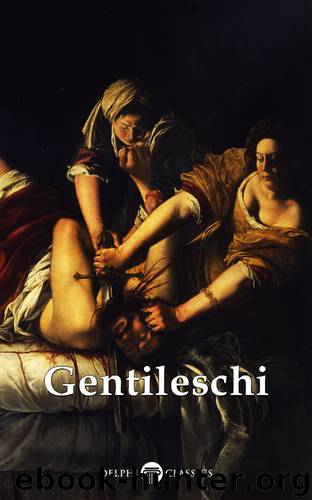Delphi Complete Works of Artemisia Gentileschi (Illustrated) by Artemisia Gentileschi

Author:Artemisia Gentileschi [Gentileschi, Artemisia]
Language: eng
Format: epub
Tags: Art History
Publisher: PublishDrive
Published: 2017-01-27T16:00:00+00:00
Detail
Detail
Detail
Detail
‘Adoration of the Magi’ by Diego Velázquez, 1619, Museo del Prado, Madrid
DAVID AND BATHSHEBA
Orazio Gentileschi died suddenly in 1639, when we know that his daughter had her own commissions to fulfil, though there are no known works assignable with certainty to this period. It is known that Artemisia had already left England by 1642, when the civil war was just starting. Nothing much is known about her subsequent movements. Historians agree that in 1649 she was in Naples again, corresponding with Don Antonio Ruffo of Sicily, who became her mentor during her second Neapolitan period. The last known letter to her mentor is dated 1650 and makes clear that she was still fully active.
Housed in the Museum of Art at Columbus, Ohio, the following image is believed to be the first painting of Gentileschi’s second residence in Naples. According to the Book of Samuel, Bathsheba was the daughter of Eliam and the wife of Uriah the Hittite, and afterward of David, by whom she gave birth to Solomon, who succeeded David as king. David’s seduction of Bathsheba, narrated in 2 Samuel 11, is omitted in the Books of Chronicles. The tale relates how David, while walking on the roof of his palace, saw Bathsheba, who was then the wife of Uriah, having a bath. He immediately desired her and later made her pregnant. In an effort to conceal his sin, and save Bathsheba from punishment for adultery, David summoned Uriah from the army in the hope that he would re-consummate his marriage and state the child was his. Uriah was unwilling to violate the ancient kingdom rule applying to warriors in active service and preferred to remain with the palace troops. After repeated efforts to convince Uriah to have sex with Bathsheba, the king gave the order to his general, Joab, that Uriah should be placed on the front lines of the battle, where it was the most dangerous, and left to the mercy of the enemy. After Uriah was dead, David made the now widowed Bathsheba his wife.
Gentileschi’s David and Bathsheba (c. 1645) portrays a partially draped Bathsheba, shown frontally in three-quarter pose, slightly to the right of centre in the foreground, before a balustrade. A kneeling maid on the left holds a silver basin with water; Bathsheba turns to the right to look at the necklace the other maid is holding out for her. In the distant background to the left, David watches Bathsheba from the balcony of a classical palace, while a maid behind and to the left of Bathsheba prepares to hand her his letter. The right background affords a view of an elegant park, and the painting of this section of the canvas is judged to be the work of Domenico Gargiolo, while the background architecture is the work of Viviano Codazzi. In later years, Gentileschi reserved her talent for the main figural work, letting her collaborators take on the more subsidiary aspects of the composition. Divine light floods in from the left, accentuating the beautiful figure of Bathsheba.
Download
This site does not store any files on its server. We only index and link to content provided by other sites. Please contact the content providers to delete copyright contents if any and email us, we'll remove relevant links or contents immediately.
The Secret History by Donna Tartt(16871)
Red Sparrow by Jason Matthews(4772)
Harry Potter 02 & The Chamber Of Secrets (Illustrated) by J.K. Rowling(3330)
In a Sunburned Country by Bill Bryson(3021)
Figure Drawing for Artists by Steve Huston(2871)
The Daily Stoic by Holiday Ryan & Hanselman Stephen(2775)
Drawing Cutting Edge Anatomy by Christopher Hart(2766)
Japanese Design by Patricia J. Graham(2621)
The Roots of Romanticism (Second Edition) by Berlin Isaiah Hardy Henry Gray John(2613)
Make Comics Like the Pros by Greg Pak(2501)
Harry Potter and the Prisoner of Azkaban (Book 3) by J. K. Rowling(2462)
Stacked Decks by The Rotenberg Collection(2344)
Harry Potter and the Deathly Hallows (7) by J.K. Rowling(2274)
On Photography by Susan Sontag(2197)
Draw-A-Saurus by James Silvani(2155)
Tattoo Art by Doralba Picerno(2134)
Foreign Devils on the Silk Road: The Search for the Lost Treasures of Central Asia by Peter Hopkirk(2117)
The Traveler's Gift by Andy Andrews(2068)
Churchill by Paul Johnson(2066)
